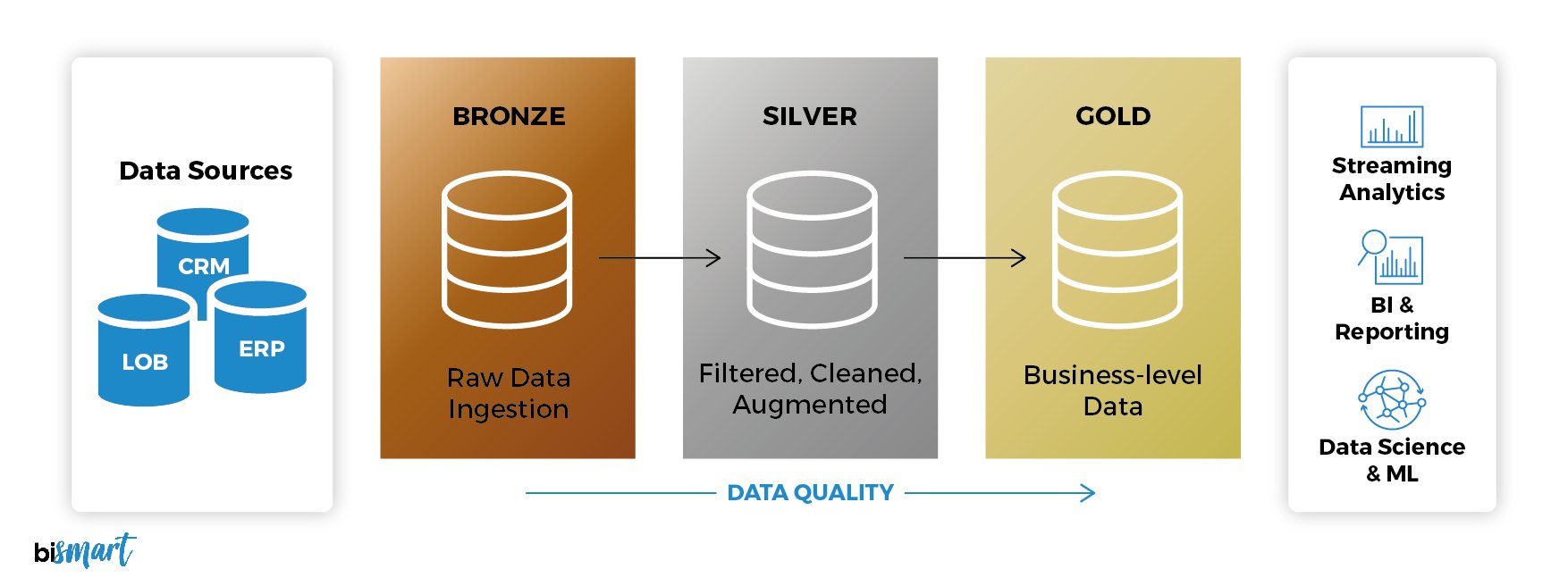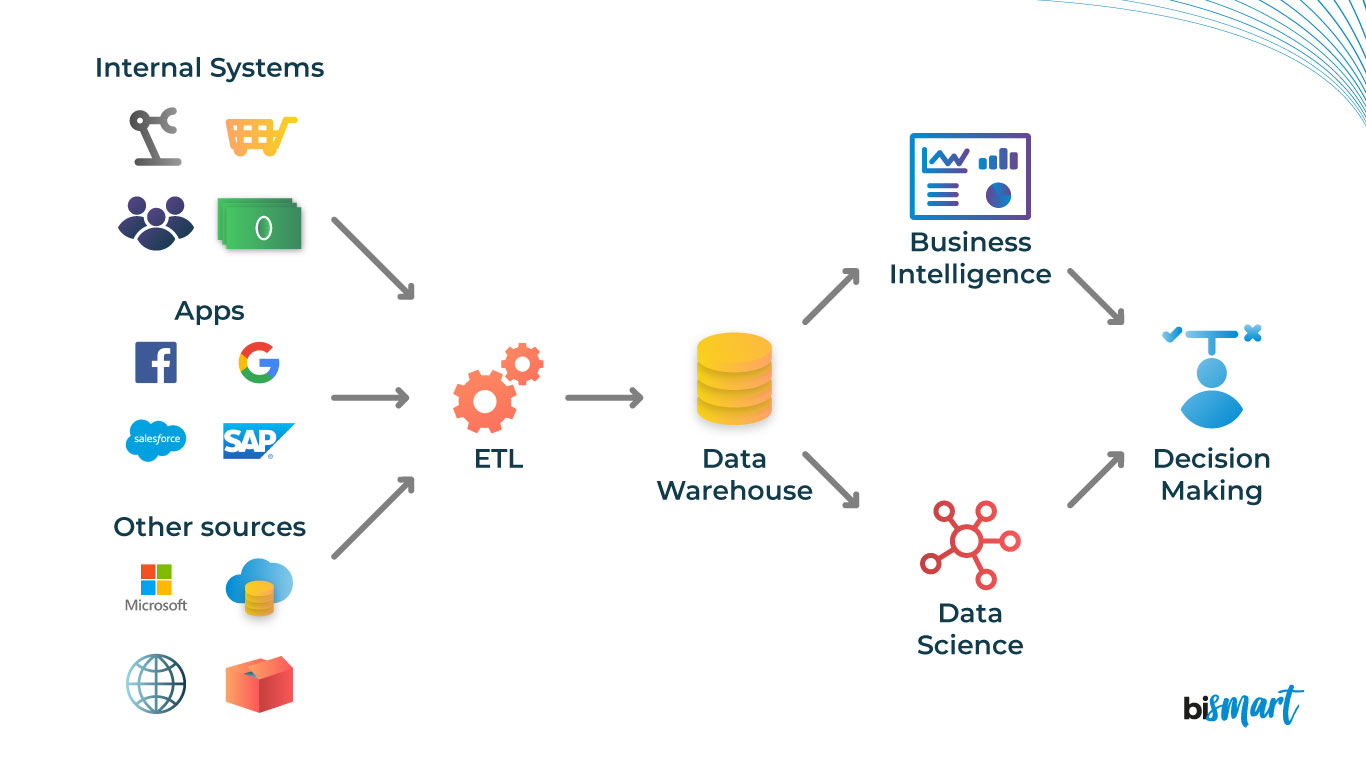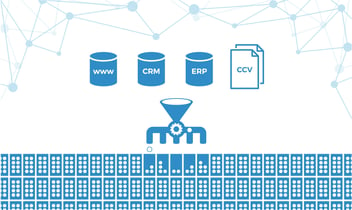Find out what a data warheouse is, what it is for, how it works, why companies need it and its use cases in data integration.
The relevance of data in today’s business landscape is undeniable.
More and more organisations are realising that data quality, organisation, and accessibility are key to effective decision-making and efficient management.
In this context, data warehouse has become a strategic necessity, while data integration stands out as an essential enabler for any modern company.
Despite this growing awareness, many companies still do not understand the differences between a conventional database and a data warehouse.
This distinction is crucial, as a data warehouse does not perform the same functions or serve the same purposes as a standard database and strengthens the foundation for good data integration, ensuring data quality and facilitating optimal data flow.
Data integration is the foundation for building a true data-driven culture within an organisation. Beyond the tools or platforms used, the real value of a seamless and productive data integration process lies in adopting best practices for data management and processing that ensure robust workflows and reliable outcomes.
At Bismart, with over 15 years of experience and deep expertise in data integration, we’ve created a downloadable e-book that gathers the essential best practices for achieving efficient enterprise data integration.
E-book: Data Integration Best Practices
In this PDF e-book, you’ll find 11 key best practices to help you optimise your data integration processes and ensure your data is accurate, efficient, and ready for analysis.
What is a Data Warehouse?
A Data Warehouse plays a central role in Business Intelligence systems by collecting, integrating and analysing data from various data sources.
It is a data integration environment that combines technologies and components to store, query and analyse large volumes of data, transforming it into valuable and accessible information for users.
Unlike a company's operational database, a data warehouse allows access to historical and current data, thus facilitating informed decision making.
Data Warehousing also refers to the process of collecting and managing data to extract valuable information.
A data warehouse can be in two states:
- Data Warehouse Offline: Data is copied from one operating system to another server, where loading, processing and reporting do not affect the performance of the operating system.
- Data Warehouse Online: Data is regularly updated from the operational database. In the case of a real-time data warehouse, the update occurs every time a transaction occurs in the relational database, such as in train or aircraft reservation systems.
The Differences Between a Data Warehouse and Other Databases
Compared to a conventional database, a data warehouse goes beyond simply storing data, preparing it for easy analysis and fostering data-driven decision making.
This process involves integrating and normalising data, ensuring compatibility and eliminating duplicates or errors. It also organises data by themes and structures, making it easy to analyse using BI tools such as Power BI.
A fundamental characteristic of data warehouses is their non-volatility and ability to adapt over time. The information stored is not lost or modified, allowing an automatically updated historical record.
This does not only facilitate temporal analysis, but also contributes to the detection of inefficiencies, the identification of opportunities and continuous improvement. In short, having a data warehouse drives innovation and a company's business intelligence strategies.
The Origin of the Data Warehouse
In 1970, Nielsen and IRI introduced the concept of dimensional data marts for retail, and in 1983, Teradata launched a database management system designed specifically for decision support.
However, it was in the late 1980s that the first enterprise data warehouse emerged, developed by Paul Murphy and Barry Devlin of IBM. This milestone marked a significant change in data management and its application for informed business decision-making.
Its innovative architecture, which facilitated the flow of data from corporate operating systems to decision support environments, marked the origin of the Data Warehouse concept.
The concept of a data warehouse has been closely linked to data-driven decision making and the efficient use of corporate data since its inception.
A data warehouse is therefore defined as a data storage and integration architecture that facilitates the organisation, transformation, understanding and management of data to make better business decisions.
The use of data warehousing has become a vital component for the proper functioning of companies, combining data storage capacity with the decision-making process based on data analysis, also known as "data-driven decisions".
eBook PDF: How to Make Data-Driven Decisions
Learn how to develop a corporate strategy that enables you to base your decisions on reliable, up-to-date, and business-relevant data. Discover the key principles and practices that turn information into insight and insight into smarter decisions.
How Does a Data Warehouse Work?
A data warehouse works as the central data repository for an organisation, acting as a convergence point for information from various sources.
This process involves the extraction of data from its original sources, followed by integration into the data warehouse. The data is then processed, transformed and organised into views, dimension tables and fact tables, using methodologies such as ETL (Extract, Transform and Load) or ELT (Extract, Load and Transform).
Once the data has been transformed and organised, users can access it in a variety of ways, whether through SQL queries, business intelligence tools such as Power BI, or customer management platforms such as a CRM.
The data warehouse provides a layer of abstraction that facilitates access to data in a structured and coherent way, allowing users to obtain relevant information for business decisions.

This central repository, the data warehouse, is vital for obtaining a complete view of critical elements, such as the customer base.
By consolidating information in one place, a comprehensive review of all data is ensured, also enabling data mining.
This process involves finding trends and patterns in the data, which are used to drive strategies to increase sales and revenue for the company.
In short, the data warehouse is an essential tool for effective data management and informed business decision-making.
What Types of Data Warehouse Exist?
There are several types of Data Warehouse, mainly classified according to their scope and use. The main types of Data Warehouse are:
-
Enterprise Data Warehouse (EDW): This is the most common and comprehensive type. It focuses on collecting data from across the organisation to provide a comprehensive and integrated view of business processes. EDW enables decision making at the executive and strategic level.
-
Data Mart: A more specific and focused version of the Data Warehouse. A Data Mart focuses on a specific functional or departmental area of the company, such as finance, human resources or sales. It is faster to implement than an EDW and can serve particular teams or departments.
-
Operational Data Store (ODS): Unlike a traditional Data Warehouse, an ODS is updated in real time and is used to store operational data in a more detailed way. It facilitates access to current data and is often used as an intermediate step before loading data into a Data Warehouse.
-
Cloud Data Warehouse: With the rise of cloud computing, cloud-based Data Warehouses have gained popularity. They use cloud infrastructure to store and process data, providing scalability and flexibility. Examples include Snowflake, BigQuery and Amazon Redshift.
-
Virtual Data Warehouse: This approach does not physically store data in one place. Instead, it uses virtualisation techniques to integrate data from multiple sources without the need for physical consolidation. This allows fast access to distributed data.
-
Federated Data Warehouse: Similar to the Virtual Data Warehouse, this type of Data Warehouse also allows the integration of data from multiple sources, but in this case, the data can be kept in its original locations and queried in a federated manner.
-
Temporal Data Warehouse: Focuses on maintaining a history of data over time, allowing for historical analysis and identification of trends over time.
Do you want to evolve your data architecture from a data warehouse to a data lakehouse?
At Bismart, we are experts in data integration and in the design of modern data architectures that enable companies to streamline their processes and operations.
The Components of a Data Warehouse
The essential components that make up a data warehouse can be broken down into three fundamental elements:
-
Load Manager: This component plays a crucial role in facilitating all operations related to the extraction and loading of data into the warehouse. In addition, it assumes responsibility for the transformation of the data, thus ensuring that it is properly prepared for subsequent use.
-
Warehouse Manager: In charge of internal operations related to data management within the warehouse, this component plays a vital role. It ensures data consistency, handles the creation of indexes and visualisations, and performs the transformation and merging of data from various sources. It also effectively manages archiving to optimise the efficiency of the system.
-
Query Manager: By addressing the appropriate tables, the Query Manager performs crucial operations related to the management of user queries. Its role is essential to ensure fast and accurate responses to information requests.
Additionally, Access Tools are incorporated, empowering end users to effectively interact with the data warehouse.
These tools not only facilitate reporting and querying, but also support application development and data mining tasks. This interactivity is key to making the most of the wealth of information stored in the data warehouse.
Companies that succeed in turning data into smart decisions don’t do it by chance. The difference lies in how they integrate, connect, and prepare their information to generate real business value.
Best Practices for Effective Data Integration
E-book: Data Integration Best Practices
This resource will help you improve the quality, reliability, and availability of your data by implementing proven practices that enhance agility and data-driven decision-making based on solid, trustworthy information.
The Layers of a Data Warehouse

1. Extraction layer (Bronze)
In this initial phase, also known as the Staging layer, data is extracted from its various sources. This process is usually done through SQL scripts or other extraction techniques, ensuring the collection of information in an efficient manner.
2. Integration layer (Silver)
Once collected, data from different sources converge at the integration layer, also known as Silver. Here, the data is stored and then undergoes a transformation and modelling process using star or snowflake schemas. This step prepares the data for analysis in an OLAP (Online Analytical Processing) server, facilitating its usefulness in strategic decision making. These extraction, transformation and loading operations are usually carried out using the ETL process.
3. Presentation Layer (Gold)
The last stage, identified as the presentation layer, is responsible for organising the data so that it is ready for consumption by users. Here, the data is carefully structured to be used and exported in various business intelligence, reporting and data visualization platforms.
Platforms such as Power BI and other front-end interfaces find in this layer the information ready to deliver insights and facilitate effective decision making.
This process completes the cycle, ensuring that the data is ready and accessible for analysis and application in the business environment.
Who Needs a Data Warehouse?
A Data Warehouse is a valuable tool for any business or professional looking to manage and analyse data efficiently.
-
Businesses of all sizes: From small businesses to large corporations, any organisation that handles considerable volumes of data can benefit from a Data Warehouse. It enables centralised and efficient management of information, facilitating analysis and informed decision making.
-
Business Intelligence (BI) teams: BI professionals benefit greatly from a Data Warehouse, as it provides them with structured and fast access to data. It facilitates the creation of reports, analyses and visualisations that support strategic decision making.
-
Data Analysts: Those engaged in data analysis, whether they are data scientists, business analysts or statistical experts, find the Data Warehouse an essential resource. It simplifies the collection and manipulation of data for deeper and more accurate analysis.
-
IT and development teams: IT and development professionals can leverage a data warehouse to efficiently manage data infrastructure, ensuring data integrity, security and availability.
-
Marketing Departments: Marketing teams benefit from access to accurate and relevant data to evaluate campaign performance, understand customer behaviour and adjust strategies in real time.Finance Departments: For financial data analysis, budgeting and forecasting, a data warehouse provides a robust platform that enables the consolidation of critical information for financial decision making.
-
Enterprises with multiple data sources: Those organisations that operate with data from various sources, such as social networks, online transactions, business management systems, among others, find in a Data Warehouse the ability to integrate and analyse this data in a coherent way.
-
Marketing Departments: Marketing teams benefit from access to accurate and relevant data to evaluate campaign performance, understand customer behaviour and adjust strategies in real time.
-
Finance Departments: For financial data analysis, budgeting and forecasting, a data warehouse provides a robust platform that enables the consolidation of critical information for financial decision making.
-
Enterprises with multiple data sources: Those organisations that operate with data from various sources, such as social networks, online transactions, business management systems, among others, find in a Data Warehouse the ability to integrate and analyse this data in a coherent way.
In short, any entity looking to leverage its data to gain valuable insights and improve decision making can benefit from a data warehouse. From strategic planning to tactical execution, this tool has become an essential asset in today's business landscape.
Advantages and Disadvantages of a Data Warehouse
Advantages of a Data Warehouse:
-
Data Centralisation: A data warehouse provides a centralised repository for data from a variety of sources, making it easier to access and manage information.
-
Data Quality: By going through extraction, transformation and loading (ETL) processes, data can be cleansed and standardised, improving its quality and consistency.
-
Efficient Analysis: Enables fast and efficient analysis of large data sets, facilitating decision making based on accurate and up-to-date information.
-
Business Intelligence (BI) Support: Essential for BI activities by providing structured and optimised data for reporting and visualisation.
-
Historical Data: Stores historical data, making it easy to analyse trends over time and track past performance.
-
Enhanced Security: Enables you to implement security measures to control access to data, ensuring the confidentiality and integrity of information.
Disadvantages of a Data Warehouse:
-
Initial Costs and Maintenance: Implementing and maintaining a Data Warehouse can be costly, both in terms of infrastructure and specialised human resources.
-
Complexity: Creating and managing a data warehouse can be complex, especially for organisations with heterogeneous data structures.
-
Implementation Time: The process of building and initial configuration of a Data Warehouse can take time, delaying the availability of tangible results.
-
Data Integration Difficulties: Integrating data from different sources can present challenges, such as the need for complex transformations to make data consistent.
-
Rigidity to Rapid Change: Can be less agile compared to more modern solutions, especially when it comes to adapting to changes in business or technology requirements.
-
Dependence on Experts: Specialised personnel are required to design, implement and maintain a data warehouse, which can be a limitation in environments where skilled professionals are in short supply.
Despite the disadvantages, careful implementation and efficient management of a data warehouse can overcome many of these challenges, providing significant benefits for business decision making.
Because of these upstream complexities, it is recommended that organisations rely on external teams with expertise in data integration and business intelligence.
Do you want to implement a data warehouse in your organisation or do you need help to solve inefficiencies linked to data integration?
Conclusion
In conclusion, the Data Warehouse emerges as a cornerstone in the contemporary business landscape, offering a clear path towards optimising data management and analysis.
Through its ability to centralise dispersed information, improve data quality and facilitate in-depth analysis, this robust system becomes a strategic ally for informed decision making.
Its advantages in terms of efficiency, security and ability to provide a comprehensive view of the business past and present are undeniable.
In a world where information is power, the Data Warehouse stands as an essential vehicle towards a more robust and future-oriented business intelligence.
Take the next step toward smarter data integration
E-book: Data Integration Best Practices
This resource will help you improve the quality, reliability, and availability of your data by implementing proven practices that enhance agility and data-driven decision-making based on solid, trustworthy information.
Free Consulting to Boost Your Data Architecture
If you need a personalised analysis of your specific case, our consultants can help you identify the best solutions to optimise your data integration and evolve your data warehouse toward a more agile, scalable, and efficient environment.
Schedule a free, no-obligation meeting and receive expert guidance tailored to your organisation’s needs.







